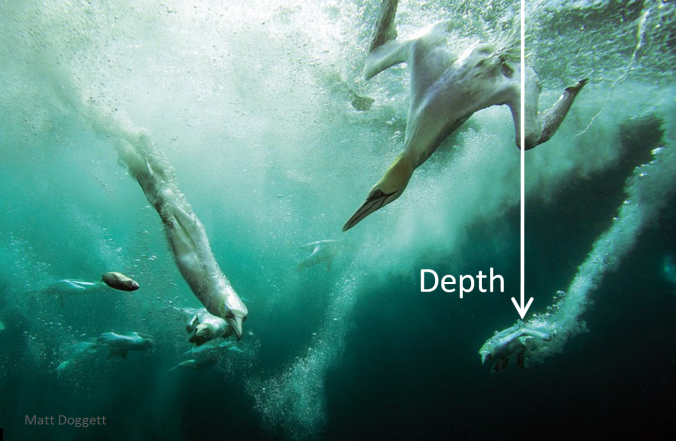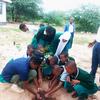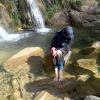Video evidence for the evaluation of behavioral state predictions
17 December 2024 11:02am
19 December 2024 12:59pm
but no "time scaling" adjustments to adjust a too "slow" or too "fast" video ?
19 December 2024 4:07pm
No, not yet. The player we attached does support slower/faster replay up to a certain precision, but I'm not sure that this will be sufficiently precise for the kind of offsets we are talking about. Adding an option on the frontend to adjust this is quite easy, but understanding the impact of this on internal timestamp handling will add a level of complexity that we need to experiment with first.
As you said, for a reliable estimate on this kind of drift we need at least 2 distinct synchronized markers with sufficient distance to each other, e.g. a precise start timestamp and some recognizable point event later on.
I perfectly agree that providing an easy-to-use solution does make perfect sense. We'll definitely see into this.
Mothbox Updates: field tests, canopy tower deployment, and fashion fundraiser!
19 December 2024 2:52pm
Announcement of Project SPARROW
18 December 2024 8:01pm
3 January 2025 6:48pm
Horizon scan of AI in nature conservation
18 December 2024 4:42pm
13 January 2025 12:56pm
13 January 2025 1:30pm
Postdoc on camera trapping, remote sensing, and AI for wildlife studies
18 December 2024 2:14pm
Sensors and data sharing for small autonomous boat (Brave Puffin)
18 December 2024 1:53pm
Birdweather Puc use as a passive sensor
13 December 2024 6:46am
13 December 2024 3:07pm
Checking the Birdweather FAQ, I guess you need to be more detailed on the setup description. For example, if you use a powerbank to power the PUC that is NOT ALWAYS-ON, it may swich-off after some time. So details of your setup may matter.
Caveat, I do not have a PUC, but tried to understand you problem.
18 December 2024 1:03pm
Thanks for the advice Wade!
It will be great to hear Tim's feedback, but thanks for your advice! I think Lithium batteries are the next step for us. I have successfully gotten it working with a power bank attached, but that really impedes its portability. Will also fiddle around with the GPS per your recommendations...
18 December 2024 1:10pm
Hello Walter
Thanks for your input. I have achieved better results with the puc when hooking it up to a powerbank. Have got them set up to "recording only", and GPS to low power mode. Looking to now try eliminating the need for a power bank as that impairs the portability of the puc.
Underwater wireless communication
9 December 2024 1:32pm
16 December 2024 6:59pm
It's probably much easier to find a company selling acoustic modems than to try and create your own...very challenging environment to work within. I have about 10 years working with underwater acoustics (as a non-engineer).
17 December 2024 1:50pm
To give you the best advice, I need a bit more information about your specific application. Underwater communication typically relies on acoustic modems because radio waves don't travel well through water. For longer distances, a hybrid solution is often used. This could involve an acoustic modem transmitting data from your underwater sensor to a surface buoy or platform. The buoy could then relay the data to shore using traditional radio communication, such as 900MHz radios (even commercially available options like Ubiquiti radios, depending on distance and line-of-sight). To help me understand your needs and recommend the right approach, could you tell me more about:
Data Rate Requirements: How much data do you need to transmit, and how often?
Range: What is the vertical distance between your sensor and the surface receiver?
Environment: Are you working in shallow or deep water? What is the water temperature, salinity, and expected noise level?
Power Budget: How much power is available for the underwater sensor and modem?
Cost: What is your budget for the acoustic modem system?
Integration: How will you integrate the modem with your sensor and surface receiving system?
Real-time or Delayed: Do you need the data in real-time, or can it be stored and transmitted later?
18 December 2024 11:56am
Steve and I are looking to develop a low-cost benthic drift camera with a live video feed. Our hope is to use an acoustic modem to give us a low quality feed for navigation / hazard avoidance. This could be as simple as a small black and white image refreshed every 1 sec. What we need to know from the system is are we at the bottom? and are we about to hit an obstacle?
Data Rate Requirements: A very low quality (360p) video stream - could be black & white and low fps to reduce bit rate requirements (hopefully 1kbps)
Range: At least depth 500m but ideally down to 2,000m (deployed below a vessel from a tether)
Environment: Deep water temperature range down to 0C. Open ocean salinity levels (33-35 psu). Limited noise apart from deployment vessel (engine & echosounder)
Power Budget: Transmitter must be powered by a battery capable of continuous working for at least 1 hour.
Cost: Ideally under £1000 (GBP) for the transmitter & receiver.
Integration: Don't know. We are hoping to plug into an arduino or equivalent.
Real-time or Delayed: We need real time transmission with very limited lag for slow moving obstacle avoidance.
It's a big ask, but any pointers would be very welcome
STEMLAB4Nature: Inspiring Conservation Through Tech &Education
18 December 2024 9:54am
Meet the winners of The Boring Fund 2024!
17 December 2024 7:36pm
18 December 2024 6:17pm
24 January 2025 5:12am
Firetail 13 - now available
10 December 2024 10:55am
13 December 2024 3:31am
Thank you so much for looking into this issue quickly! Much appreciated.
17 December 2024 10:40am
I promised to keep you updated, and the article is now available here:
17 December 2024 10:42am
and a short contribution in this e-obs setup, where we used Firetail VideoSync to analyze motion-triggered camera footage:
¿Conoces colecciones de sonidos de la biodiversidad en América Latina? / Você conhece coleções de sons da biodiversidade na América Latina?
17 November 2024 6:30pm
2 December 2024 2:44pm
He compilado esta lista de bibliotecas de referencia acústica!
I've compiled this list of acoustic reference libraries!
16 December 2024 3:01pm
Carly!
Está fantástica la lista. Me gusta la idea de diferenciar las colecciones de sonido y los conjuntos de dato para machine learning.
Acá comparto información sobre nuestra colección de sonidos ambientales:
- Colección de Sonidos Ambientales: https://colecciones.humboldt.org.co/sonidos/ , Multiple taxa, Global, 25k recordings, 1.3k species, mantenido por el Instituto Humboldt desde 1997.
Este recurso de BioacousticsIA me pareció particularmente interesante ya que está público, tiene una clara estrategia para mantenerlo al día y está diseñado para incluir muchos detalles sobre los conjuntos de grabaciones.
Muchas gracias! :D
16 December 2024 6:06pm
Added!
¡Agregada!
Detecting Thrips and Larger Insects Together
16 December 2024 1:14pm
16 December 2024 2:32pm
16 December 2024 2:36pm
Yeah, I would expect that you might need to have higher resolution if the critters are very small. Still might be just a lens choice. But not up on this amount of lens difference, so don't know how hard it would be.
16 December 2024 2:48pm
So, updated the text a bit with images cropped at 100% zoom :) we are already happy with the time reductions we got, but... would like to get at least 90% time reduction instead of 70% :))) we know that with a very expensive and high power camera we could probably do it, so one approach we are thinking of is just taking a closer macro picture with a cellphone of let's say 1/3 or 1/4 of the sticky paper and use this data instead of everything... or take 2-3 pictures (but we don't want to waste time in sticking the images together).
Christmas wish list
16 December 2024 11:22am
16 December 2024 1:25pm
Oh there we go, you are selling this setup? Really cool!!!
Great Idea, just posted my requirements here:
lets see if I can find my dreamsolution.
16 December 2024 1:33pm
Yes, I have these. I'm pretty sure that my company is the first company in the world to sell products running on Raspberry Pi 5 in secure boot mode as well :-)
I responded to your wish list. From your description a modified camera like a HIKvision turret might be able to do it for you.
16 December 2024 2:24pm
great, this security cameras might be interesting for monitoring crop development and maybe other bigger pests like boars or some other herbivorous animals that could eventually go into the fields, but this is not what I'm trying to solve now. What I also have interest in is on the go weeds species monitoring, like on a robot, to create a high resolution map of weed infestation in a field (10-20 hectares). There eventually such modified camera could make sense. Thanks for the ideas!!
Postdoc on camera trapping, remote sensing, and AI for wildlife studies
16 December 2024 9:52am
Susan and Conservation outreaches
16 December 2024 5:54am
October + November 2024 OSS paper round-up
15 December 2024 7:05pm
Advancing Conservation Through Technology: My Academic Journey
15 December 2024 2:09pm
Integrating wildlife tracking with other technologies
7 January 2016 12:21pm
27 June 2016 3:59pm
Hi Paul,
I just remembered another one for the list. @BethClark is taking some really cool environmental readings for seabirds - Gannets - basically to build a picture of their lives in 3D. She talks about it on her blog here.
A few excerpts:
Electronic devices are attached onto the birds to record their behaviour: GPS, altimeters, accelerometers and dive recorders. The key will be to use multiple loggers on the same bird to record their flights in great detail. The GPS tracking project has been going on Grassholm for a few years now and we are building up a good picture of where they tend to forage.
The altimeters show the height above the sea, which gives us 3D tracks of the birds’ movements – very cool! The higher you are, the further you can see, but the more difficult it is to pick up scents from the sea. We will find out if these 3D help us pick out foraging behaviour and see how they actually find fish (and fishing boats) in a huge and seemingly featureless ocean.
Dive recorders show the timing and depth of the famous torpedo plunge dives, which will let us know when the birds have successfully found a fishing ground.
The accelerometers measure acceleration in 3 directions, showing even a single wing flap. This will help us to measure how much effort the bird are putting in when they travel and forage, which is very important for trying to figure out how they decide where to go. We will also be able to identify other behaviours, such as telling apart high-speed plunge diving from a slower dive made from the surface.
I think altimeters and dive recorders might be new ones for your list. Beth's here on WILDLABS.NET (and has promised a nice case study for our Resources area), so I think she'd be delighted to answer any questions you might have.
Cheers,
Steph

16 August 2016 10:37am
Hello again!
An interesting paper exploring the new technologies being used to study cetaceans has a section devoted to what they term high-resolution multisensor tags (page 4).
As with @BethClark 's work above, the questions that arise when studying marine mammals bring another dimension into what information we might require sensors to collect. For example:
Among cetaceans, there are two suborders: Odontocetes (toothed-whales) and Mysticetes (baleen whales). In general, toothed whales and dolphins use high-frequency acoustics for interanimal communication and feeding. In the marine environment, where sight is limited, sound propagates extremely well and all marine mammals communicate primarily through acoustic cues. Similar to bats, toothed whales and dolphins feed via high-frequency sound production known as echolocation, where acoustic signals reflect off of targets and the returning echoes can be translated into information on the environment or potential prey. For many years, independent passive acoustic recorders have been used to study the vocalizations of marine mammals. However, the incorporation of acoustic recorders (hydrophones) into animal-borne tags has only occurred in the past 20 years (Fletcher, Le Boeuf, Costa, Tyack, & Blackwell, 1996). The information that is recorded on the sensors in these tags (e.g. acoustic, movement) can be used to determine the frequency and acoustic structure of vocal behaviours that occur concomitant with motor behaviour, for example, echolocation signals during feeding events (Madsen, De Soto, Arranz, & Johnson, 2013) or contact calling while diving ( Jensen, Marrero Perez, Johnson, Aguilar Soto, & Madsen, 2011). Echolocation ‘clicks’ and ‘buzzes’ have been used from animal-borne tags to study the foraging behaviour of a wide range of odontocetes, from the small harbour porpoise, Phocoena phocoena, to the largest, the sperm whale (Fais et al., 2015; Wisniewska et al., 2015). This information has provided critical data on the feeding depths, frequency, timing and prey types targeted by different species and the behaviours associated with foraging (Johnson, de Soto & Madsen, 2009). These insights into feeding behaviour have recently been used to help determine foraging performance and foraging ecology (Watwood, Miller, Johnson, Madsen, & Tyack, 2006), as well as the energetic consequences of disturbing this behaviour (Miller et al., 2009). These new data products are ripe for linking to conservation efforts such as the individual and population consequences of human activities disrupting these behaviours (e.g. the use of naval sonar and seismic surveys). We explore below the tools produced, as well as new ones in development, to forge these links.
You have already identified sound in your original list, but I think the use of hydrophones with tags is an interesting addition - an example that didn't immediately spring to mind (at least for me), when I thought about the list.
Cheers,
Steph
In Press: Nowacek, D. P., et al., Studying cetacean behaviour: new technological approaches and conservation applications, Animal Behaviour (2016), http://dx.doi.org/10.1016/j.anbehav.2016.07.019
14 December 2024 12:18am
Hi Both of you,
Just a quick note now. Very interesting articles and topics found and discussed here. In my work with biophysical aspects of cheetahs I will review these things you have written. Thank you very much. Followed here from the sidelines
BR Henrik
Human mobility data
13 December 2024 4:09pm
Insect call library
6 December 2024 8:28pm
6 December 2024 11:53pm
Hi Iqbal,
Xeno-canto has expanded the taxonomic scope and now has some insect calls there. There are a few insect-focused libraries listed on this compilation of bioacoustic reference libraries too. I believe there are aquatic invertebrates being added to the Freshwater Sounds Archive as well (led by @JackGreenhalgh). Ed Baker from NHM would be a good person to talk to - he's done a ton of work on insect bioacoustics.
Hope that helps a bit!
-Carly
9 December 2024 3:39pm
Hi Carly,
I've found and made use of Xeno-canto's libraries in the past, but for the current project plan to actually build a library myself. Thanks for the pointer to Ed Baker, I'll definitely follow up on it.
Cheers,
Iqbal
13 December 2024 1:36pm
Hi Iqbal,
I'm sure you could get some good feedback on this from XC users on this, particularly on the subject of protocols, recording settings, etc. So maybe a nice idea to post it on the forum there.
cheers,
Bob
Xeno-canto.org
Tracking orangutans
29 October 2024 3:15pm
6 December 2024 12:59pm
Depending on what you really need, you might have different options. I don't think collar/bracelet for great apes is currently resolved reliably, and could pose risks to the animals. Implantable transmitters are one option but more invasive. I think Chris Walzer (currently at WCS) has done some initial work on implanting orangutans (or gibbons), but that was quite some years ago. Others might have done it since as well. FWIW we have implanted captive chimpanzees with subcutaneous transmitters for other reasons and some have removed/damaged it, so that's a risk. Intraabdominal might be another (though even more invasive) option.
Is visual observation an option? This is well used in many species, though might be very costly/labour intensive. I have been involved in a project with howler and spider monkey where this has been used successfully, happy to put you in touch with them.
If your questions is primarily absence/presence of certain individuals, you could also try DNA based methods? And someone suggested below individual ID from video/pictures, this has been done in captive great apes, so it is an option, but you still need to get the shots in the first instance, so probably not many advantages over manual monitoring methods.
10 December 2024 6:46am
Our city-neighbours Robotto are a Drone AI-software company and have an ongoing animal tracking projects in Thailand, Australia, and Greenland (probably more by now) in co-op with WWF, using drones.
Give them a look! I know Kenneth, their CEO, pretty well so can match you two.
A rough explanation of how the tracking process happens is:
A forest ranger brings a suitcase with a drone to a watchpoint, pilots the drone around the area for 30-50 minutes while monitoring detections real-time on the provided screen.
Have seen it live in Thailand, it was impressive! :)
13 December 2024 3:44am
In a recent call with researchers in Thailand. They have mentioned that they use passive chip readers to log data about chipped animals as they pass by.
FEISTY Fortran library and R package to integrate fish and fisheries with biogeochemical models
Query Regarding ArcMap
15 November 2024 2:21pm
12 December 2024 1:19pm
Sure
12 December 2024 1:20pm
I'll see that but I actually prefer ArcMap so that's why
12 December 2024 1:22pm
Thankyou so much. I'll definitely apply these solutions
WILDLABS Reaches 10,000 Members
11 December 2024 7:19pm
18 December 2024 6:07pm
On The EDGE's Conservation Grants program opens call (£30K) for early and mid career conservationists and small organizations.
11 December 2024 5:30pm
Will Everglade pythons eat Patagonian beavers?
11 December 2024 5:00pm






























19 December 2024 11:53am
Currently, the main focus is visual footage as we don't render audio data in the same way as we do for acceleration (also: the highly different frequencies can be hard to show sensibly side by side).
But In this sense, yes, the new module features 'quick adjust knobs' for time shifts: you can roll-over a timestamp and use a combination of shift/control and mouse-wheel to adjust the offset of the video by 1/10/60 seconds or simply enter the target timestamp manually down to the millisecond level. This work can then and also be saved in a custom mapping file to continue synchronisation work later on.